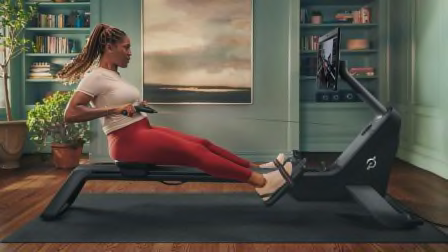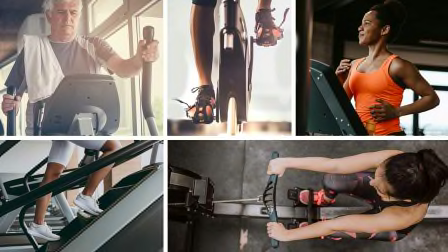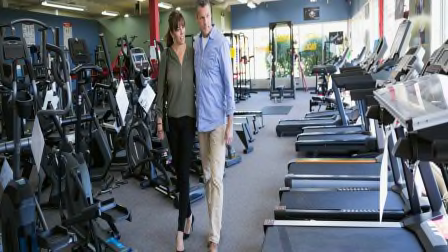How to Use a Rowing Machine to Get a Great Workout
Our beginner's guide will help you achieve proper form and adjust settings so you can reap the benefits of this full-body, low-impact exercise

If you are looking to knock out an intense cardio workout and build some strength at the same time, it’s hard to beat working out on a rowing machine. These devices—also known as rowing ergometers or ergs—are great for both lighter cardio and endurance workouts, too. And they can be a perfect choice for someone looking for a lower-impact exercise because even at high intensities, your body is never pounding the ground as when you go for a run.
Rowing machines mimic the motion and feel of rowing on water. But while most people who use a treadmill know how to run, and most people who use an exercise bike have ridden a bike outside, many people trying out an erg probably don’t have any experience with rowing. That’s why trying a rowing machine for the first time can be intimidating, says Katie Wason, lead coach and director of programming at Regatta Fitness, an app that offers on-demand workout classes with a focus on rowing.
Many people might first hop on an erg with misunderstandings about how to use it or what proper form looks like. One common misconception is the idea that rowing is primarily an upper-body workout. “It’s rather a lower-body exercise that incorporates the upper body,” says Michael Rogers, PhD, a professor of human performance studies and research director for the Center for Physical Activity and Aging at Wichita State University in Kansas.
Learning proper form can help you generate a lot more power and get a better workout, plus it’ll help reduce the risk of any injuries. Whether you’re considering a new machine for your home (see our picks here) or just looking to give something new a try at the gym, here are some tips for getting started.
Why Try Rowing?
While rowing is a low-impact workout—your body isn’t pounding the ground as it would when you go for a run—it can be as high intensity as you want it to be.
How to Achieve Proper Form
Form “is something you need to work on and learn to do properly in order to get all the benefits,” Wason says.
To get started, first get a feel for the machine itself. Sit on the seat and strap your feet into the footpad, with the straps around the widest part of your foot. You can slide back and forth to get a sense of the movement, and test how it feels to pull the handle—your oar.
You can break the motions of rowing down into four parts: the catch, drive, finish, and recovery. The catch and finish are your starting and ending positions. You push back and generate power during the drive and slide back to get ready for your next stroke during the recovery.
To get to the correct starting position (the catch), slide forward until your shins are perpendicular to the ground. Grasp the handle lightly with both hands, with your fingers on top and thumbs underneath. With your back long and straight and core engaged, you want to hinge slightly forward. If sitting vertically is 12 o’clock on a clock, think of hinging to 1 o’clock. Your neck and shoulders should be relaxed.
Next up is the drive. If it’s helpful, you can think about three separate movements here: legs, body, and arms. A majority of your power is generated by your legs. Start by pushing off to extend your legs. Once your legs straighten, hinge back slightly to 11 o’clock. Then finish the stroke by pulling your arms until the handle is almost touching your rib cage. You are now in the finish position: arms pulled close, hinged slightly back with a straight spine, and legs extended.
For the recovery, you want to perform the reverse of the drive back, Wason says. First, let your arms extend forward, then hinge your torso forward to 1 o’clock, and finally slide back to the catch position until your shins are vertical. You can do this slowly. For starters, you can think about it as about half the speed of your drive back, Wason says.
Do this motion slowly until you get the rhythm of things. You can always isolate parts of the motion until they feel natural. Start in the finish position, and try just doing the arm portion of the stroke for a while, for example. Set up your phone to record a video of yourself if you want to see how you’re doing, because it’s hard to look into a mirror and keep your body in the correct position, Wason suggests.
Many people find it helpful to at least briefly work with a coach or watch some tutorial videos, Wason says. There may be someone at your gym who can coach you through a rowing workout, you could check out a rowing-focused gym, or you could try an app like Regatta. But you can also find plenty of tutorials on YouTube. Dark Horse Rowing is one very popular and well-regarded channel, Wason says, and you can also find starter tutorials from Concept 2, the maker of what’s probably the most popular rowing machine you’ll find at gyms.
What to Know About Rowing Metrics
Once you get the rhythm of rowing down, you’ll want to understand how much distance you’re covering, how quickly you’re moving, and how much power you’re generating.
Total distance covered (measured in meters) will be displayed on the monitor of most ergs. Distance and time can be used as the basis for many workouts.
You can set the monitor on many machines to display watts, the power you’re generating with each stroke. This can be used to set goals for workouts, Wason says. You could estimate your average max watt output as approximately your body weight plus 10 percent (though many people can generate even higher levels for a short sprint). A person who weighs 150 pounds could estimate their max watt output at 165 watts, for example. You might set a goal in a workout to row at about 50 percent of that max (between 80 and 85 watts in our example), then increase to 75 or 90 percent for brief intervals, for example.
Another key factor that you’re going to want to look at is your stroke rate, measured in strokes per minute. You’ll want to get used to rowing at different stroke rates and trying to keep to a consistent pace.
But note that rowing more slowly isn’t always easier. You may have to use more power to get the flywheel spinning with each pull. For slower workouts, you’ll be under 24 strokes per minute, down to 18, or perhaps even 16. Most workouts take place between 24 and 30 strokes per minute, according to Concept 2. And sprint paces will exceed 30 spm.
On your monitor, you’ll also see measures of your average time per 500 meters or 500-meter pace for these workouts. Don’t worry about this too much as a beginner, Wason says. But eventually, you may want to use these metrics to set goals, trying to hit a certain average pace.
Erg Settings: Resistance, Drag, Damper
While you can adjust settings on various ergs in different ways that affect resistance, the resistance or intensity of your workout is determined more by the power you’re applying to each stroke.
Many of the settings you can adjust have more to do with how each stroke feels, so you don’t want to automatically crank levers up as high as you can, thinking you’ll get the best workout, Wason says.
On rowers like the Peloton Row and Hydrow Rower, you can adjust the drag factor or drag setting. Default settings are meant to make rowing feel similar to rowing on water, according to Hydrow. As Peloton explains, adjusting this doesn’t automatically make your workout harder or easier. Both companies recommend using their default drag settings (115 for Peloton, 104 for Hydrow) unless you’re doing a specific workout that calls for an adjustment.
On Concept 2 row ergs, which is what you’ll find in many gyms, you’ll see a lever called the damper connected to the fan cage that can be set to a number between 1 and 10. On a clean, well-maintained machine, a setting between 3 and 5 is the right choice for most rowers and workouts (for everyone from beginners to Olympians), according to Concept 2.
Once you get a little more used to rowing, you may want to take things a step further and use the damper to hit a certain drag factor. See explanations of this from Concept 2 or Dark Horse Rowing.
A Few Workouts to Try
If it’s your first time using an erg, or if you’re still getting comfortable with the motion of rowing, you don’t need to do anything fancy. Try just rowing for 5 to 30 minutes to get used to the exercise and work on your form, Wason suggests.
Before any workout, you can try using what’s called a pick drill or reverse pick drill to warm up. For a pick drill, start at the finish position: legs extended, body back, and arms pulled in. Row with just your arms for a minute or so. Then incorporate the hinge, rowing with arms and body for another minute. Next incorporate some leg movement with a half slide after you hinge forward, still pulling your arms in after you hinge back. Finally, switch to the full stroke. A reverse pick drill does the same steps in reverse. Start at the catch with just a half push, proceed to the full leg extension, then incorporate the body hinge, and then the arms.
You can then row for some time or distance: 2k, 5k, or 10k, for example.
You could also build endurance by warming up and then targeting a certain percentage of your max watts or a certain 500m pace for a few rounds of rowing, with some easy rowing in between.
You could also do some higher-intensity intervals, dropping to a low-intensity easy row between each. Try to increase your watt output or pace with each interval. Or to build power, see how you can increase power output (watts) while maintaining the same stroke rate.
After any of these workouts, it’s helpful to do a 3- to 5-minute easy cooldown.
























